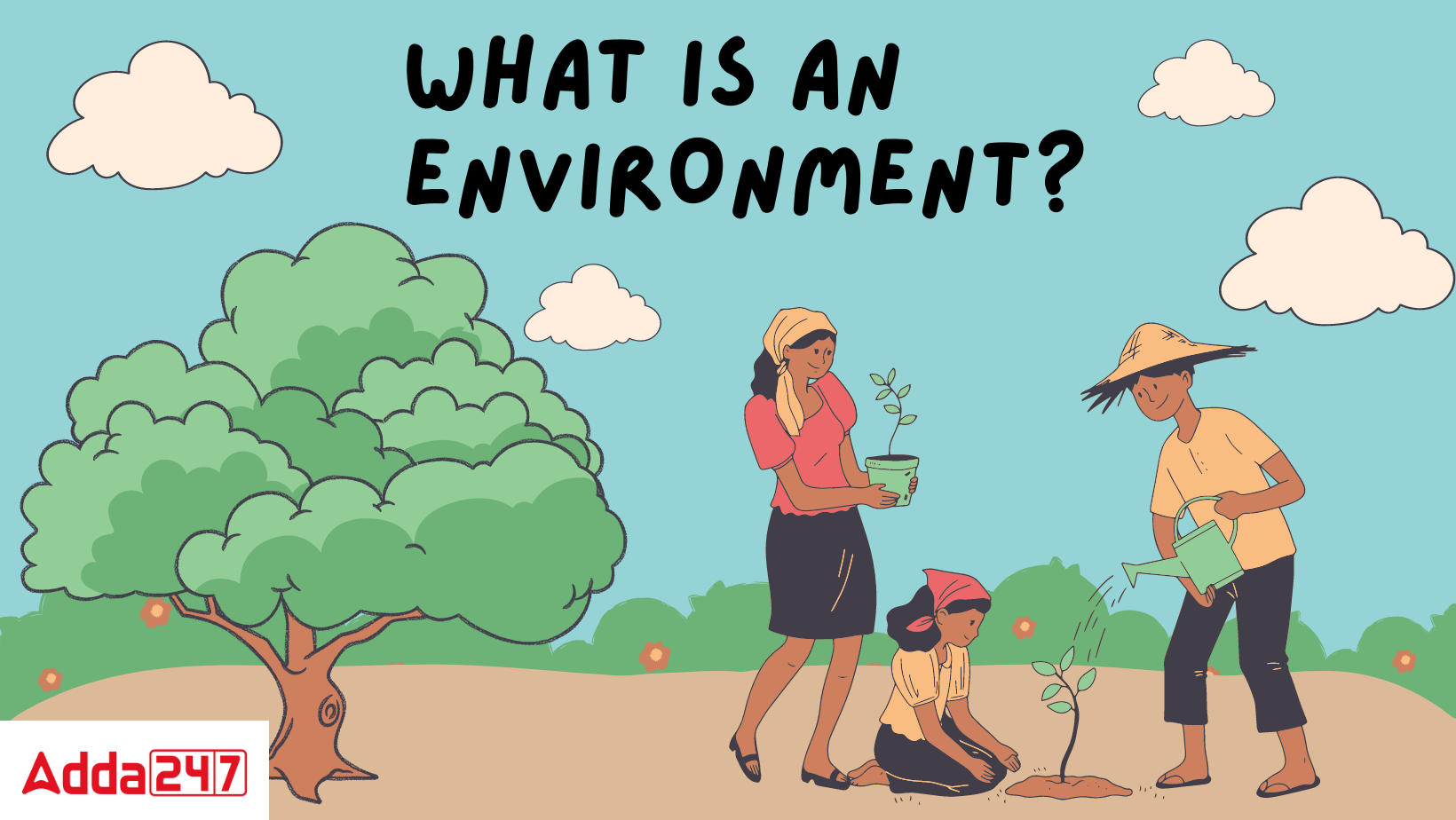Table of Contents
What is Environment
An environment can be simply defined as a system that includes all biotic and abiotic components that have an impact on human life. All flora and animals are considered biotic, or living, elements, whereas water, sunlight, air, climate, etc. are considered abiotic.
Define Environment
An environment, in a general sense, refers to the surroundings or conditions in which a living organism, system, or activity exists and operates. It encompasses both the physical and non-physical elements that can impact and interact with the subject in question. Environments can vary widely in scale and complexity, and they play a crucial role in shaping and influencing the behavior, development, and well-being of individuals, organisms, or systems.
Here are a few specific definitions of “environment” in different contexts:
Ecological Context: In ecology, the environment refers to the natural surroundings in which organisms live, including factors like climate, terrain, vegetation, and other living organisms. It includes both biotic (living) and abiotic (non-living) components.
Human Environment: In the context of human activities, the environment encompasses the physical, social, cultural, and economic factors that influence the quality of life and well-being of individuals and communities. This can include factors like air and water quality, housing, employment opportunities, and social interactions.
Computing and Technology: In computer science and technology, an environment can refer to the hardware and software components and settings within which a program or system operates. This includes the operating system, hardware devices, and configurations that can impact the behavior of software applications.
Psychological and Cognitive Environment: In psychology and cognitive science, the environment can refer to the external stimuli, social context, and situational factors that influence an individual’s thoughts, feelings, and behavior.
Business and Economics: In business and economics, the environment often refers to the external factors and conditions that can affect a company’s operations, such as market conditions, regulatory policies, competition, and economic trends.
Global Environment: In discussions related to environmental conservation and sustainability, the global environment encompasses the entire planet’s ecosystems, climate systems, and natural resources, as well as the human impact on these systems, including pollution, deforestation, and climate change.
The term “environment” can take on different meanings depending on the context, but it generally refers to the surroundings, conditions, or context in which something exists and operates. Understanding and managing various types of environments are crucial in fields ranging from biology and ecology to technology and business.
What do You Mean by Environment
An environment’s resources can be any good, service, or feature that benefits people and society. They might be anything that fulfills a person’s daily needs. Environmental resources include food provided by living things and plants, energy used for transportation and cooking, wind, and oil, among others.
The environment provides a wide range of goods and services needed to support life. Each resource is valuable and has a certain level of importance. For instance, a plot of land could be developed into a park, housing development, shopping center, etc. It can also be transformed into a place to deposit trash.
Read more: Environmental Pollution Essay in English 1000 words
What is an Environment Pollution
Environmental pollution is the unjustified discharge of mass or energy into the planet’s natural resource pools, such as the atmosphere, water, or land, which has a negative long- or short-term ecological impact on the health of living things and their quality of life. Environmental pollution is a measurement of the contamination of the earth’s living and nonliving (physical and biological) constituents in a way and to a degree that has a negative impact on the environment’s normal, optimal processes.
What is Environment Day?
Every year on June 5, the United Nations observes Environment Day (WED), which serves as their main platform for promoting environmental protection awareness and action.
The United Nations Environment Programme (UNEP), which established Environment Day, calls it “a global forum for encouraging constructive change.”
With millions of participants in more than 150 countries, it is currently the greatest global environmental event. In order to raise awareness and celebrate environmental action, “governments, corporations, civic society, schools, celebrities, cities, and communities” are encouraged to participate.
What is Environmental Sustainable development?
By eradicating poverty, combating climate change, and other economic-affecting variables, sustainable development seeks to meet our needs without compromising those of our children and grandchildren. As a result, we’ll go into great length in this part about how the environment and sustainable development are related.
It mostly fits within the category of green environmental technologies. In some aspects, sustainable growth is a subset of sustainable development, and it aims to expand the market for green products in order to significantly reduce the ecological footprints of those items.
This indicates that we should take steps to improve human existence while preserving and protecting Mother Nature by using organic products.
What is Environmental degradation?
Environment degradation is the deterioration of the environment as a result of resource depletion, including poor soil, water, and air quality, ecosystem disruption, habitat loss, the extinction of wildlife, and pollution. Any alteration or disturbance to the environment that is deemed harmful or undesirable is what is meant by this definition.
The detrimental impacts of any human activity on the environment are referred to as environmental concerns. Both the biological and physical aspects of the environment are considered. Air pollution, water pollution, natural environment pollution, trash pollution, and other major environmental issues are some of the most concerning.
What is Environmental Answer
Through the process of environmental education, people can learn about environmental problems, solve them, and take steps to protect the environment. People have a deeper grasp of environmental issues as a result, and they are more equipped to make wise choices.
The following are elements of environmental education:
- Sensitivity to environmental issues and environmental awareness.
- Knowledge of the environment, including environmental challenges.
- Concern for the environment and a desire to maintain or improve environmental quality.
- Ability to recognise and address environmental issues.
- Taking part in actions that help to solve environmental problems.
What is Environmental Protection?
Environmental protection is concerned with finding solutions to difficulties that result from interactions between people and natural systems, such as conservation, pollution, biodiversity loss, land degradation, or environmental policy.
The main goal of environmental protection is to stop the natural environment from deteriorating due to factors like population growth, technology, and excessive consumption, all of which have a detrimental impact on the environment and continue to put people and animals in danger.
What are the Environmental Activities?
The Environment Allows Life to Exist
Life-sustaining services are provided by the environment without human intervention. Some of them include ecological diversity, UV protection, and climatic stability.
It raises and improves living standards.
A clean environment is required for a healthy way of life. Aside from this, people can appreciate and find happiness in all-natural aesthetic wonders like mountains, seas, deserts, etc. To maintain wellbeing, humans must, however, make sure to protect all of the natural resources and refrain from polluting them.
It Generates Resources for Use.
The environment is the source of all natural resources, including both renewable and non-renewable energy sources. A majority of them are necessary for survival. Both biotic and abiotic sources are used by organisms. Plants and animals provide us with food and animal products. The dead and decaying stuff of organic substances is used to create fossil fuel. The environment also supplies freshwater, wind, and even metals, which are additional ecosystem components.
Waste materials are absorbed by the environment.
Waste materials can be assimilated by the environment without harming other living things. Pollution results when absorption rises above the assimilative threshold. The ability of plants that live in water bodies to absorb chemicals, pathogens, etc. is an illustration of this type of aptitude.
Environment Functions
Environment Examples
some examples of different types of environments and the unique characteristics and functions they serve:
1. Forests
- Example: Amazon Rainforest
- Functions: Carbon sequestration, biodiversity habitat, oxygen production, water cycle regulation.
- Benefits: Provides medicinal plants, timber, and food resources. Supports indigenous communities and global biodiversity.
2. Wetlands
- Example: Florida Everglades
- Functions: Water purification, flood control, carbon storage, biodiversity habitat.
- Benefits: Supports unique wildlife, provides water filtration, and acts as a buffer against storms and flooding.
3. Oceans
- Example: Great Barrier Reef
- Functions: Climate regulation, carbon sequestration, habitat for marine life, nutrient cycling.
- Benefits: Supports fisheries and tourism, protects coastal areas from erosion, and maintains global biodiversity.
4. Grasslands
- Example: African Savanna
- Functions: Soil formation, carbon storage, habitat for wildlife, water infiltration.
- Benefits: Supports grazing for livestock, maintains biodiversity, and provides ecosystem stability.
5. Deserts
- Example: Sahara Desert
- Functions: Mineral resource supply, solar energy potential, unique biodiversity.
- Benefits: Provides minerals and fossil fuels, supports unique cultures and species adapted to arid conditions.
6. Freshwater Ecosystems
- Example: Great Lakes
- Functions: Freshwater supply, habitat for aquatic life, nutrient cycling, recreation.
- Benefits: Provides drinking water, supports fisheries and recreation, and maintains biodiversity.
7. Tundra
- Example: Arctic Tundra
- Functions: Carbon storage, habitat for unique wildlife, climate regulation.
- Benefits: Supports indigenous cultures, maintains permafrost which stores carbon, and provides unique research opportunities.
8. Mountains
- Example: Himalayas
- Functions: Water regulation, habitat diversity, climate regulation.
- Benefits: Source of fresh water for millions, supports diverse ecosystems, and provides recreational and spiritual value.
9. Urban Environments
- Example: Central Park, New York City
- Functions: Recreation, air quality improvement, urban heat island mitigation.
- Benefits: Provides green space for recreation, improves air quality, and reduces urban temperatures.
10. Coral Reefs
- Example: Coral Triangle
- Functions: Coastal protection, habitat for marine species, nutrient cycling.
- Benefits: Supports fisheries, protects coastlines from storms and erosion, and provides tourism opportunities.
These environments highlight the diverse roles ecosystems play in maintaining ecological balance and supporting human life and activities.



 CUET PG Result 2025 Soon @exams.nta.ac.i...
CUET PG Result 2025 Soon @exams.nta.ac.i...
 NEET Admit Card 2025 Release Date, How t...
NEET Admit Card 2025 Release Date, How t...
 CUET UG 2025 Vs CUET UG 2024, Check Majo...
CUET UG 2025 Vs CUET UG 2024, Check Majo...










